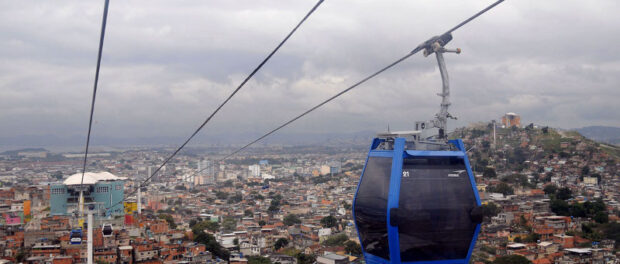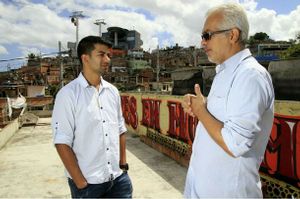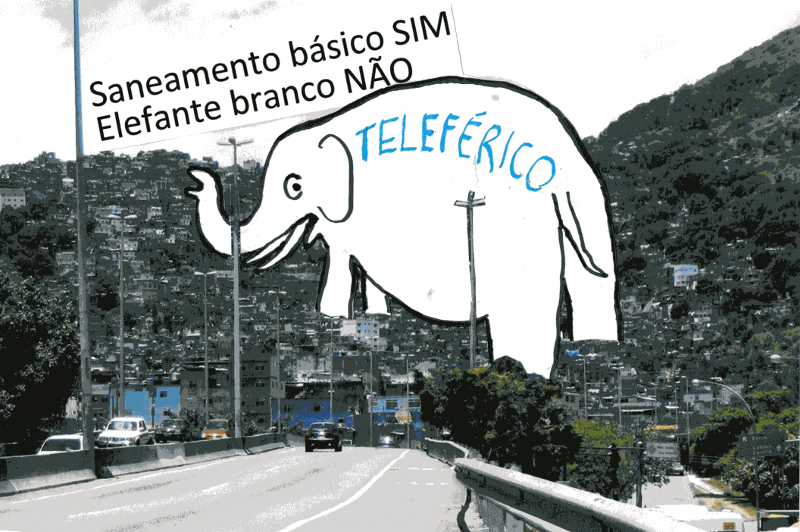
For the original by Cláudia Freitas in Portuguese for Jornal do Brasil click here.
Residents of both communities are against the construction and want continuity of Growth Acceleration Program (PAC) works
Star of an international soap opera and a new tourist point in Rio de Janeiro, the cable car joining the favelas of Complexo do Alemão, in the North Zone of the city, was designated as the ‘flagship’ for improvements promised by the state government to the pacified community, as part of Growth Acceleration Program (PAC) and received some R$210 million in investment by both federal and state government. Two years after its inauguration on July 7, 2011, the Alemão cable car is the target of criticism from residents; according to them, it does not meet the basic needs of mobility, social integration and improving their quality of life, as was suggested in the original project which was inspired by the model in the Colombian city of Medellín.
The unsuccessful experience is serving as an example to the community of Rocinha, in the South Zone, destined to have the third cable car in Rio. Representatives from Rocinha Sem Fronteiras (Rocinha Without Borders) are promoting resistance actions against the planned installation of a cable car in the community. Allied with the Instituto Raízes em Movimento from Alemão, they will go to the Public Ministry presenting a case against Rio’s government denouncing the violation of human rights and arguing non-compliance with federal law 10.257, which requires public participation in decisions regarding government interventions, in the case of Alemão, and for the non-execution of PAC-1 works in Rocinha.
‘PAC and Sanitation–Rocinha Case Studies’ was the subject debated at the Urban Mobility Forum held by the Rio de Janeiro Engineers Club on September 20. Counselor of the club, Alcebíades Fonseca, stated in his speech that looking at the Alemão cable car it is easy to see that this type of transport is not viable for Rio communities as it does not provide a solution to mobility problems and has very high maintenance costs, since the machinery is imported from France. “Wheelchair users find no access when they arrive at the station for their journey. It’s the same with residents carrying their shopping,” explained the engineer. As a comparison, Fonseca cited the funicular tram in Santa Marta, which according to him would be a better option for Rocinha. “The system in Santa Marta facilitates access for disabled people, allows for waste disposal and its construction is much cheaper, with a projected installation that corresponds to only 20% of the total value of the imported cable car project presented by the Rio government,” said Fonseca.
The coordinator for the Instituto Raízes em Movimento from Complexo do Alemão, Alan Brum, said that the Basic Plan for Bidding and Sustainable Development for their community had been discussed intensely with representatives from the Rio de Janeiro State Construction Company (Emop) and with State departments for parks and gardens and culture and leisure since 2008. At that time, the Development Committee for the Serra da Misericórdia (forested hills in Alemão) was created, comprised of 927 members from regional institutions and of residents who voiced their complaints to improve the quality of life in the region, by being included within planned urbanization. The final result was the Proactive Agenda which was then delivered to public officials.
 “When they commented on the cable car, we immediately warned that it would not work because of the topography, no one will climb up the hill to get on. We believed that the PAC investment was vital to implement alternative transport, widening both main and secondary roads and, most importantly, ensuring basic sanitation. These are the factors that truly reflect the wishes of Rocinha,” said Alan.
“When they commented on the cable car, we immediately warned that it would not work because of the topography, no one will climb up the hill to get on. We believed that the PAC investment was vital to implement alternative transport, widening both main and secondary roads and, most importantly, ensuring basic sanitation. These are the factors that truly reflect the wishes of Rocinha,” said Alan.
Whilst the implementation of the Alemão cable car was a priority for Governor Sérgio Cabral of the PMDB party, the majority of planned works within PAC are still just on paper. Alan said that work on opening up access to the main road in Alemão, Joaquim Queiroz, equated to only 300 meters of paving and a new announcement from the government promising to complete the work, yet with still no definition of when it will be resumed. “The cable car is a tourist attraction and the pride of the state government. To please tourists’ eyes, they [the state government] built a social belt surrounding Alemão, with a pretty public school, emergency health clinic, crèche and housing blocks. But this is only in the areas where tourists go. If you go into the community, you will come face to face with the results of state negligence, the true precariousness we try to combat,” he said.
Alternative transport, according to Alan, continues to be discriminated against by the government, despite being the main means of transport for the community. Another critique by residents is what they call ‘Exotic Tourism,’ which Alan sees as an official service which strengthens prejudices that have always existed towards the favelas. “A tourist embarks at Bonsucesso Station, at the bottom of the hill, passes over Alemão and heads directly to Palmeiras Station, where you find beautiful views of Rio and all this service infrastructure which was approved by the government to please visitors. From there, they go back down and that’s it, the visit is over. Where is the social interaction that the government said would happen between tourists and the community? Business in Alemão is strong, but this is not from ‘Exotic Tourism,’ which is separate and does not contribute to the local economy,” stated the social coordinator.
The central criticism is the fact that the cable car does not match the performance anticipated by the government. With 152 carriages, each with the capacity to transport 10 people, the cable car was expected to become the main mode of transport in Alemão, predicted to have 30,000 passengers a day, taking the 3.5 kilometer ride from the entrance to the top of the hill in 16 minutes. However, daily demand by residents using the cable car is only 12,000 even though they have the right to two free journeys and there is a promotional ticket price of R$1. For tourists the journey cost is R$5. December 15, 2012 had the record number of passengers, with more than 19,000 embarking on the system, which is integrated with the suburban rail network via the Bonsucesso/TIM Station.
Alan’s notes since the first activities of the Development Committee for Serra da Misericórdia, with analyses of social and urban development in Alemão made alongside state authorities, were put together in a dossier and given to the leader of the Rocinha Sem Fronteiras movement, José Martins de Oliveira. For several months, the leaders from the two communities have come together to better understand common problems. “It’s been possible to identify the same precariousness in Rocinha, in Alemão and probably in all other Rio favela communities,” commented Davison Coutinho, participant in the Rocinha Sem Fronteiras movement and member of the Residents Commission for Rocinha, Vidigal and Chácara.
 Davison visited Complexo do Alemão on Thursday, September 26 and in the meeting he had with Alan highlighted how “the structural and social problems of these regions come from a bigger problem, which is the lack of resident participation in decision-making regarding Rio government’s intervention works, undermining federal law number 10.257, which demands public inclusion in such processes.” According to community representatives, Sérgio Cabral’s government holds official meetings with the public but only to present the PAC project. “Residents complain, criticize and offer opinions, yet nothing is heard, the government does what it wants. Also because the company responsible for the social side to PAC, that must accommodate resident’s decisions, is contracted by the concessionary, it’s obvious they can’t go against the government’s wishes. It is a false participation by residents in the meetings where they collect signatures and photos and send them all to the Ministry of Cities, as if these communities agreed with their proposals. The cable car is not a priority for the communities and this was already proven at the Urban Mobility Forum held by the Engineers Club, which we took part in a short time ago. The money from PAC in Alemão and Rocinha must be put into basic sanitation, since it has been proven that every dollar spent on sanitation represents US$5 saved on health. This money should be put back into structuring public policy, such as mobility, transport, health, education, culture, social services. All of these data are within the reports produced by the government alongside the communities, but are not forwarded to the federal government,” denounced representatives from Rocinha and Alemão.
Davison visited Complexo do Alemão on Thursday, September 26 and in the meeting he had with Alan highlighted how “the structural and social problems of these regions come from a bigger problem, which is the lack of resident participation in decision-making regarding Rio government’s intervention works, undermining federal law number 10.257, which demands public inclusion in such processes.” According to community representatives, Sérgio Cabral’s government holds official meetings with the public but only to present the PAC project. “Residents complain, criticize and offer opinions, yet nothing is heard, the government does what it wants. Also because the company responsible for the social side to PAC, that must accommodate resident’s decisions, is contracted by the concessionary, it’s obvious they can’t go against the government’s wishes. It is a false participation by residents in the meetings where they collect signatures and photos and send them all to the Ministry of Cities, as if these communities agreed with their proposals. The cable car is not a priority for the communities and this was already proven at the Urban Mobility Forum held by the Engineers Club, which we took part in a short time ago. The money from PAC in Alemão and Rocinha must be put into basic sanitation, since it has been proven that every dollar spent on sanitation represents US$5 saved on health. This money should be put back into structuring public policy, such as mobility, transport, health, education, culture, social services. All of these data are within the reports produced by the government alongside the communities, but are not forwarded to the federal government,” denounced representatives from Rocinha and Alemão.
Leader of Rocinha Without Borders, José Martins de Oliveira, a community resident for 47 years, says many failures can be noted in the implementation of PAC-1 and 2. Martins believes the biggest mistake of the PAC-2 project is in the construction of the cable car, which takes the largest slice from the budget and does not follow the wishes of the local population. “It’s an unwanted gift,” claims Martins. He stated that PAC-1 works were discussed in 2005, prioritizing basic sanitation in Rocinha and planning development over 10 years as part of the Social Development Plan. Within this project, construction of a cable car was never mentioned. In 2007 works began, but were paralyzed by the state government in 2010, with more than 25% of the project pending including basic sanitation. PAC-2 includes completion of these works but prioritizes the cable car in Rocinha.
“The same situation as Alemão will happen in Rocinha. People won’t use the cable car and it will end up just being transport for tourists. Various projects were provided for, buildings were torn down and a lot was left to be done. Sanitation, which was the greatest demand of residents, still hasn’t happened. The right path to take is discussing with the community what should be done with the funds,” he stated. Whilst the government won’t go to the community to discuss PAC-2 , Martins is calling on residents to join regular meetings addressing the main reference points for the community development project.
Currently, the main demand of residents from both communities is that the Ministry of Cities give heed to their priorities. “We have combined forces so that together we can strengthen efforts towards action for the greater good of the people,” said Alan and Davison. In partnership with the Rio State Legislative Assembly’s Commission for Human Rights, chaired by representative Marcelo Freixo of the PSOL Party, Alan Brum will go to the State Public Ministry (MP/RJ) and the State Court for Accounts (TCE) against the government of Rio, demanding completion of the unfinished work of PAC and accountability to residents of all expenditures within the project. Governor Sérgio Cabral must face another lawsuit related to PAC. “We are looking to the Public Ministry of Rio and will pressure for completion of work related to PAC-1 in Rocinha. We will sue the State for non-completion of a promised project,” announced José Martins, on behalf of Rocinha Without Borders.
Emop guarantees more investment for Rocinha
According to the Rio de Janeiro State Construction Company (Emop), Rocinha will receive federal and state investment of nearly R$1.6 billion to implement infrastructure, housing and urban redevelopment projects. “The projects will prioritize implementation of drainage systems, sewerage systems, water and light, the installation of waste disposal collection services, opening of roads and extension of Roads 1, 2 and the Estrada da Gávea,” says the letter sent by the agency to Jornal do Brasil.
The letter also states that the cable car is an alternative proposal to deal with urban mobility, “so that residents can reach the highest parts of the community which will be integrated with other mass transport systems such as the metro, with a station in lower Rocinha, and integration with support lines of the metro in the higher parts, alongs with the Gávea neighborhood.” According to Emop, recent funding will permit the construction of a crèche and housing for families relocated from areas of risk or areas removed for completion of the project, which is still being drafted.
The message also stated that at least 15 meetings with the community to discuss the project will take place. “Up to now six meetings have happened, with participation by around 1,000 residents. The works will prioritize sanitation, as that is the wish of the community, who also approve construction of the cable car with some exceptions, which is obvious and natural for a community of more than 100,000 residents.” The company concludes by stating that on the issue of mobility in Rocinha they are also contemplating a funicular tram, but there are no further details about this project.
